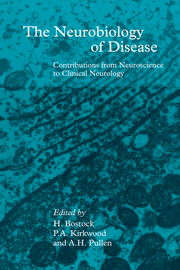Book contents
- Frontmatter
- Contents
- List of contributors
- Preface
- Part I Physiology and pathophysiology of nerve fibres
- 1 Ion channels in normal and pathophysiological mammalian peripheral myelinated nerve
- 2 Molecular anatomy of the node of Ranvier: newer concepts
- 3 Delayed rectifier type potassium currents in rabbit and rat axons and rabbit Schwann cells
- 4 Axonal signals for potassium channel expression in Schwann cells
- 5 Ion channels in human axons
- 6 An in vitro model of diabetic neuropathy: electrophysiological studies
- 7 Autoimmunity at the neuromuscular junction
- 8 Immunopathology and pathophysiology of experimental autoimmune encephalomyelitis
- 9 Pathophysiology of human demyelinating neuropathies
- 10 Conduction properties of central demyelinated axons: the generation of symptoms in demyelinating disease
- 11 Mechanisms of relapse and remission in multiple sclerosis
- 12 Glial transplantation in the treatment of myelin loss or deficiency
- Part II Pain
- Part III Control of central nervous system output
- Part IV Development, survival, regeneration and death
- Index
4 - Axonal signals for potassium channel expression in Schwann cells
from Part I - Physiology and pathophysiology of nerve fibres
Published online by Cambridge University Press: 04 August 2010
- Frontmatter
- Contents
- List of contributors
- Preface
- Part I Physiology and pathophysiology of nerve fibres
- 1 Ion channels in normal and pathophysiological mammalian peripheral myelinated nerve
- 2 Molecular anatomy of the node of Ranvier: newer concepts
- 3 Delayed rectifier type potassium currents in rabbit and rat axons and rabbit Schwann cells
- 4 Axonal signals for potassium channel expression in Schwann cells
- 5 Ion channels in human axons
- 6 An in vitro model of diabetic neuropathy: electrophysiological studies
- 7 Autoimmunity at the neuromuscular junction
- 8 Immunopathology and pathophysiology of experimental autoimmune encephalomyelitis
- 9 Pathophysiology of human demyelinating neuropathies
- 10 Conduction properties of central demyelinated axons: the generation of symptoms in demyelinating disease
- 11 Mechanisms of relapse and remission in multiple sclerosis
- 12 Glial transplantation in the treatment of myelin loss or deficiency
- Part II Pain
- Part III Control of central nervous system output
- Part IV Development, survival, regeneration and death
- Index
Summary
Introduction
Following a report of voltage-gated Na+ and K+ currents in cultured Schwann cells (Chiu, Shrager & Ritchie, 1984), various kinds of voltage-gated ionic channels have been found in glial cells in the peripheral and central nervous systems (Barres, Chun & Corey, 1990). Among these ionic channels in glial cells, inwardly rectifying potassium (Kir) channels are important for the regulation of the potassium microenvironment in the nervous system by potassium siphoning (Newman, Frambach & Odette, 1984; Konishi, 1990) or spatial potassium buffering (Orkand, Nicholls & Kuffler, 1966). This chapter focuses on the mechanism of the expression of functional Kir channels in mouse Schwann cells in relation to axonal contact, intracellular cAMP and neuronal activity, and discusses the physiological significance of Schwann cells in potassium regulation.
Axonal contact
In cultured Schwann cells obtained from dissociated sciatic nerves of neonatal mice, only voltage-gated outward currents were recorded with the whole-cell patch-clamp technique during depolarizing voltage steps (Konishi, 1989). The equilibrium potentials of the tail currents indicated that these outward currents were carried by potassium ions (Konishi, 1989). They were eliminated by bath application of quinine, but were not affected by external barium (Konishi, 1990). In freshly dissociated Schwann cells from neonatal sciatic nerves, both myelinating and non-myelinating cells showed bariumsensitive inward currents during hyperpolarizing voltage steps, which were disclosed by subtracting a record in a solution containing barium from a record in standard solution (Fig. 4.1) (Konishi, 1992).
- Type
- Chapter
- Information
- The Neurobiology of DiseaseContributions from Neuroscience to Clinical Neurology, pp. 37 - 46Publisher: Cambridge University PressPrint publication year: 1996
- 1
- Cited by

